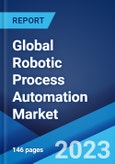The global robotic process automation market size reached US$ 3.1 Billion in 2022. Looking forward, the market is expected to reach US$ 14.8 Billion by 2028, exhibiting a growth rate (CAGR) of 29.76% during 2022-2028.
Robotic process automation (RPA) refers to an advanced software technology that builds, deploys, and manages software robots. It aids in manipulating data, passing data from different applications, triggering responses, or executing transactions. It also assists in streamlining workflows and increasing employee satisfaction, engagement, and productivity by eliminating repetitive tasks from their workdays. Apart from this, it offers greater resilience and higher accuracy, and accelerates transformation, improves compliance and boosts productivity. As it is also scalable, requires minimal investment, and provides a significant return on investment (ROI), the application of RPA is expanding among numerous industry verticals across the globe.
Robotic process automation (RPA) refers to an advanced software technology that builds, deploys, and manages software robots. It aids in manipulating data, passing data from different applications, triggering responses, or executing transactions. It also assists in streamlining workflows and increasing employee satisfaction, engagement, and productivity by eliminating repetitive tasks from their workdays. Apart from this, it offers greater resilience and higher accuracy, and accelerates transformation, improves compliance and boosts productivity. As it is also scalable, requires minimal investment, and provides a significant return on investment (ROI), the application of RPA is expanding among numerous industry verticals across the globe.
Robotic Process Automation Market Trends
Due to the coronavirus disease (COVID-19) outbreak and consequent imposition of lockdown restrictions, there is a considerable rise in the shift towards remote working to comply with government regulations, continue business operations and prevent the spread of the pandemic. This represents one of the key factors driving the market. Moreover, RPA helps in inducing quick execution and the arrangement of a large volume of data in less time than mechanical procedures with reduced overhead expenditure for enterprises. Consequently, it is increasingly being utilized in the banking, financial services, and insurance (BFSI), healthcare, information technology (IT), and telecom industries worldwide. Furthermore, leading players are integrating RPA with advanced technologies, such as machine learning (ML), which is advancing the capabilities of software bots beyond rule-based processes. It is also allowing task execution like human decision-making skills. Additionally, these players are utilizing artificial intelligence (AI) to handle cognitive processes that require skills, such as understanding documents, visualizing screens, and comprehending speech and carrying on conversations and chats.Key Market Segmentation
This research provides an analysis of the key trends in each sub-segment of the global robotic process automation market report, along with forecasts at the global, regional and country level from 2023-2028. The report has categorized the market based on component, operation, deployment model, organization size and end user.Breakup by Component:
- Software
- Services
Breakup by Operation:
- Rule-based
- Knowledge-based
Breakup by Deployment Model:
- On-premises
- Cloud-based
Breakup by Organization Size:
- Large Enterprises
- Small and Medium Sized Enterprises
Breakup by End User:
- BFSI
- Healthcare and Pharmaceuticals
- Retail and Consumer Goods
- IT and Telecommunication
- Government and Defense
- Transportation and Logistics
- Energy and Utilities
Breakup by Region:
- North America
- United States
- Canada
- Asia-Pacific
- China
- Japan
- India
- South Korea
- Australia
- Indonesia
- Europe
- Germany
- France
- United Kingdom
- Italy
- Spain
- Russia
- Latin America
- Brazil
- Mexico
- Middle East and Africa
Competitive Landscape
The competitive landscape of the industry has also been examined along with the profiles of the key players being Amelia US LLC, Automation Anywhere Inc., AutomationEdge, Blue Prism Group PLC, Infosys Limited, International Business Machines Corporation, Kofax Inc., NICE Ltd., Pegasystems Inc., UiPath, Verint Systems and WorkFusion Inc.Key Questions Answered in This Report:
- How has the global robotic process automation market performed so far and how will it perform in the coming years?
- What has been the impact of COVID-19 on the global robotic process automation market?
- What are the key regional markets?
- What is the breakup of the market based on the component?
- What is the breakup of the market based on the operation?
- What is the breakup of the market based on the deployment model?
- What is the breakup of the market based on the organization size?
- What is the breakup of the market based on the end user?
- What are the various stages in the value chain of the industry?
- What are the key driving factors and challenges in the industry?
- What is the structure of the global robotic process automation market and who are the key players?
- What is the degree of competition in the industry?
Table of Contents
1 Preface3 Executive Summary13 Value Chain Analysis15 Price Analysis
2 Scope and Methodology
4 Introduction
5 Global Robotic Process Automation Market
6 Market Breakup by Component
7 Market Breakup by Operation
8 Market Breakup by Deployment Mode
9 Market Breakup by Organization Size
10 Market Breakup by End User
11 Market Breakup by Region
12 SWOT Analysis
14 Porters Five Forces Analysis
16 Competitive Landscape
Companies Mentioned
- Amelia US LLC
- Automation Anywhere Inc.
- AutomationEdge
- Blue Prism Group PLC
- Infosys Limited
- International Business Machines Corporation
- Kofax Inc.
- NICE Ltd.
- Pegasystems Inc.
- UiPath
- Verint Systems
- WorkFusion Inc.
Methodology

LOADING...
Table Information
| Report Attribute | Details |
|---|---|
| No. of Pages | 146 |
| Published | November 2023 |
| Forecast Period | 2022 - 2028 |
| Estimated Market Value ( USD | $ 3.1 Billion |
| Forecasted Market Value ( USD | $ 14.8 Billion |
| Compound Annual Growth Rate | 29.8% |
| Regions Covered | Global |
| No. of Companies Mentioned | 12 |









